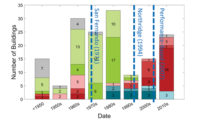In a truly unlucky day for millions of homeowners, Hurricane Charley blasted through parts of southwestern and central Florida on Friday, Aug. 13. Winds of up to 145 mph blew aparts utilities, buildings and homeseven though some were built under codes implemented after Hurricane Andrew hit south Florida in 1992.
 |
| Researchers are analyzing structural damage in Hurricane Charley's wake for evidence of need to improve code or building practices. (Photo by Jeremy Gilstrap) |
Initial forecasts had Charley hitting the Tampa Bay area as a Category 2 storm. But it unexpectedly turned and struck as a Category 4 storm further south, rampaging through southwest and central Florida. Public officials advised approximately 2-million people to evacuate.
Charley pummeled Lee and Charlotte counties with winds exceeding 145 mph before heading northwest. As of Aug. 17, 19 were reported dead; more than 700,000 were still without power and some2,300 remained in shelters. Twenty-five of Floridas 67 counties were declared disaster zones. Damages to insured structures alone may reach $14 billion. ![]() (An experimental wind analysis map created for research by the National Oceanic and Atmospheric Administration's Hurricane Research Division uses preliminary data to track maximum sustained wind swaths in mph for Hurricane Charley. It is expected to be modified as new data become available. Click here to view map>>)
(An experimental wind analysis map created for research by the National Oceanic and Atmospheric Administration's Hurricane Research Division uses preliminary data to track maximum sustained wind swaths in mph for Hurricane Charley. It is expected to be modified as new data become available. Click here to view map>>)
In the wake of Hurricane Andrew, Florida officials reevaluated the state's building code (ENR 2/1/1993, p.26). A 1994 mobile home standard called for stronger fasteners that attach roofs, walls and floors, stronger windows and uniformity of tie-downs to the ground. Under the new code, mobile homes should withstand 110-mph winds. But that wasn't enough for 150,000 mobile homes in the affected 10-county area, which incurred significant damage.
In 1997, a code provision requiring that hospitals wisthstand winds up to 146 mph was also put in place for all new Florida hospital construction. But Charlotte County's three hospitals, built prior to 1997, sustained major damage. One had to relocate 50 hospitalized people.
|
Theres only so much you can do [in the way of protection] when winds reach what they did with Charley, says Bruce Houghton, principal with Ranon & Partners Architects, Inc., in Tampa, Fla. What surprised me was how many buildings were being used that didnt meet shelter requirements. When we do schools there are very specific requirements for the rooms that meet shelter requirements for schools. And theyre rather costly to do. I was surprised to see them putting people into places that didnt meet those requirements.
Materials, construction techniques and construction quality are being investigated throughout the damage zone "to make sure the code is being met," according to engineers with Simpson StrongTie Co. Inc., a manufacturer of tie-down hardware and systems. Randy Shackelford, a Simpson research engineer, says he is particularly looking for evidence of damage from lateral loads on walls. "There isn't nearly as much attention given to lateral wind loads as to [roof tie-downs for] uplift." Window protection also will be scrutinized, he says, noting instances of roofs coming apart, sending tiles into windows of other buildings.
Tim Reinhold, vice president of engineering at the Institute for Building and Home Safety, Tampa, an insurance industry group, used mobile anemometers to gather wind-speed data during the storm and are using it while investigating damage to assess "whether we are moving in the right direction with code standards." According to the standard building code for 2002, addressing high velocity hurricane zone...


Post a comment to this article
Report Abusive Comment